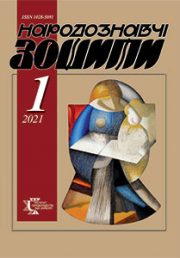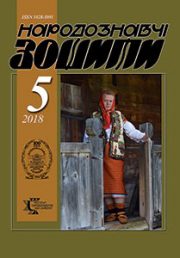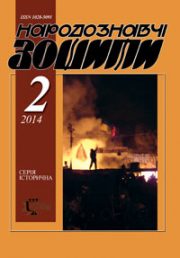The Ethnology Notebooks. 2022. № 4 (166), 836—849
UDK 392.8+615.89(477.81/.82+476):634.73
DOI https://doi.org/10.15407/nz2022.04.836
DMYTRENKO Alla
- ORCID ID: https://orcid.org/0000-0001-6125-8628
- Candidate of History, docent,
- Lesya Ukrainka Volyn National University,
- Department of museum and monument studies
- and Information and Analytical Activities,
- Volia Avenue, Lutsk, 43000, Ukraine,
- Contacts: e-mail: dmytrenko.a@gmail.com
Abstract. The purpose of the article is to highlight the ethnocultural features of the use of cranberries in the life support (food and folk medicine) of the inhabitants of the Right Bank Polissia of Ukraine and changes that have occurred in the system of berry use in recent decades. Problems with the use of cranberries have not been the subject of special ethnological research, which is the novelty and relevance of this article. Objectives: to highlight the main methods of cleaning harvested cranberries; to reveal the features of «dry» and «wet» methods of storing harvested berries; analyse the place of cranberries in the daily diet: fresh, cooked and as part of certain dishes; show the role of cranberries in the treatment of various diseases; pay attention to the use of cranberries in modern cooking, official medicine and as a tourist/festival brand; to note the growing role of berries in the formation of the family budget of modern Polissia families.
The object of the research is collecting as a form of livelihood for the residents of the Right Bank Polissia, the subject is the traditionally formed system of using cranberries in food and folk medicine.
The source base consisted of field materials collected during historical and ethnographic expeditions (2005—2014), organized by the State Research Centre for Protection of Cultural Heritage from Man-Made Disasters and the Museum of Ethnography of Volyn and Polissia at Lesya Ukrainka’s Volyn National University.
The methodological basis was based on the principles of structural-functional and systemic approaches, methods of descriptive-analytical and contextual analysis were used, collection of field ethnographic materials was carried out according to the author’s questionnaires by the spray method.
Keywords: Right Bank Polissia, ethnic culture, gathering, berries, cranberries, national food, folk medicine.
Received 26.05.2022
REFERENCES
- Davydyuk, M. (2006). Traditional food of Volyn. Folk art and ethnography, 1, 38—50 [in Ukrainian].
- Boltarovich, Z.E. (1990). Folk medicine of Ukrainians. Kyiv: Naukova dumka [in Ukrainian].
- Sirenko, S. (2020). Berry fishing in Lyubeshiv region (according to field research). Past and present of Volyn and Polissia: Lyubeshiv region in the history of Ukraine and Volyn (Issue68, pp. 200—205). Lutsk: PE Ivanyuk V.P. [in Ukrainian].
- Sirenko, S. (2021). Berry fishing Manevychi (according to field materials). Past and present of Volyn and Polissia. Manevychi, Czartorysk and Kukly in the history and culture of the native land (Issue71, pp. 54—62). Lutsk; Manevichi [in Ukrainian].
- Museum-Archive of Folk Culture of Ukrainian Polissya of the State Scientific Center for Protection of Cultural Heritage from Man-Made Disasters (hereinafter — MANKUP DNCZKSTK). F. Rokitne-2006 (Rokytne district of Rivne region) [in Ukrainian].
- MANKUP DNTSZKSTK. F. Zarichne-2010 (Zarichne and Dubrovytsia districts of Rivne region) [in Ukrainian].
- MANKUP DNTSZKSTK. F. Yemilchyne-2011 (Yemilchyn and Novohrad-Volynskyi districts of Zhytomyr region) [in Ukrainian].
- MANKUP DNTSZKSTK. F. Sarny-2008 (Sarny and Dubrovytsia districts of Rivne region) [in Ukrainian].
- MANKUP DNTSZKSTK. F. Vladimirets-2009 (Volodymyrets and Dubrovytsia districts of Rivne region) [in Ukrainian].
- MANKUP DNTSZKSTK. F. Volodarka-2012 (Volodarsky and Vasylkivsky districts of Kyiv region) [in Ukrainian].
- MANKUP DNTSZKSTK. F. March 2013 (Bereznivsky, Kostopilsky. Sarny districts of Rivne region) [in Ukrainian].
- MANKUP DNTSZKSTK. F. Stone-Kashirsky-2012 (Kamin-Kashirsky and Ratnivsky districts of Volyn region) [in Ukrainian].
- MANKUP DNTSZKSTK. F. Lugini-2005 (Luhyny, Ov ruch and Korosten districts of Zhytomyr region) [in Ukra inian].
- Archive of the Museum of Ethnography of Volyn and Polissya at the Volyn National University named after Lesya Ukrainka. F.Field ethnographic practice «Ratne-2011» (Ratniv district of Volyn region) [in Ukrainian].
- Archive of the Museum of Ethnography of Volyn and Polissya at the Volyn National University named after Lesya Ukrainka. F. ethnographic practice «Stobikhva-2010» (Kamin-Kashirsky district of Volyn region) [in Ukrainian].
- Archive of the Museum of Ethnography of Volyn and Polissya at the Volyn National University named after Lesya Ukrainka. F. ethnographic practice «Stobikhva-2010» (Kamin-Kashirsky district of Volyn region) [in Ukrainian].
- Archive of the Museum of Ethnography of Volyn and Polissya at the Volyn National University named after Lesya Ukrainka. F. ethnographic practice «Stobikhva-2010» (Kamin-Kashyrskyi district of Volyn region) [in Ukrainian].
- Archive of the Museum of Ethnography of Volyn and Polissya at the Volyn National University named after Lesya Ukrainka. F. ethnographic practice «Stone-Kashirsky-2014» (Kamin-Kashirsky and Lyubeshiv districts of Volyn region) [in Ukrainian].
- Archive of the Museum of Ethnography of Volyn and Polissya at the Volyn National University named after Lesya Ukrainka. F. ethnographic practice «Shatsk-2013» (Shatsky district of Volyn region) [in Ukrainian].
- Archive of the Museum of Ethnography of Volyn and Polissya at the Volyn National University named after Lesya Ukrainka. F. materials on various issues of traditional culture. 2000—2004 (Volyn, Rivne, Lviv regions) [in Ukrainian].
- (2021). Berry business in Ukraine: how to make money growing cranberries Retrieved from: https://business.24tv.ua/yagidniy-biznes-ukrayini-yak-zaroblyati-viroshhuvanni-zhuravlini_n1768684 (access date 12.01.2022) [in Ukrainian].
- (2021). Cranberries: 45 recipes. Retrieved from: https://cookorama.net/uk/ingredient/%D0%B6%D1%83%D1%80%D0%B0%D0%B2%D0%BB%D0%B8%D0%BD%D0%B0 / (application date 14.01.2022).
- (2021). On the beneficial properties of cranberries and lingonberry. Retrieved from: https://www.ukrinform.ua/rubric-yakisne-zhyttia/3159343-pro-korisni-vlastivosti-zuravlini-ta-brusnici.html (access date 14.01.2022) [in Ukrainian].
- (2017). Folklore and ethnographic festival «Cranberry». Retrieved from: http://rocnt.com.ua/?p=867 (access date 15.01.2022) [in Ukrainian].
- (2018). Nikolaychuk, V. «Cranberry Festival» in the village. Olmani. Retrieved from: https://rivnenskyipz.blogspot.com/2018/11/blog-post.html (access date 14.01.2022) [in Ukrainian].
- (2021). 75th Annual Bandon Cranberry Festival. Retrieved from: https://bandon.com/cranberry-festival/ (access date 14.01.2022).
- (2021). Cranberry Festivals in 2021: Where, When and More to Find an Cranberry Festival Near You! Retrieved from: https://pickyourown.org/Cranberry-Festivals.php (access date 14.01.2022).
- (2021). This weekend, the Cranberry Festival will be active, tasty and interesting. Retrieved from: https://koscierski.info/artykul/juz-ten-weekend-festiwal/1216889 (access date 14.01.2022) [in Polish].
- (2021). Nantucket Cranberry Festival reimagined. Retrieved from: https://www.nantucketconservation.org/events/cran berry-festival/ (access date 14.01.2022).
- (2021). VIII Festival Cranberry Festival. Retrieved from: https://www.miastokoscierzyna.pl/asp/viii-festiwal-festiwal-zurawiny,156, article, 1.3319 (access date 14.01.2022).
- (2021). Warrens Cranberry Festival. Retrieved from: https://www.uscranberries.com/news-links/2021-cranberry-festivals/ (access date 14.01.2022).
- Kliap, M.P., Shandor, F.F. (2011). Modern varieties of tourism: Textbook. manual. Kyiv: Znannja [in Ukrainian].







